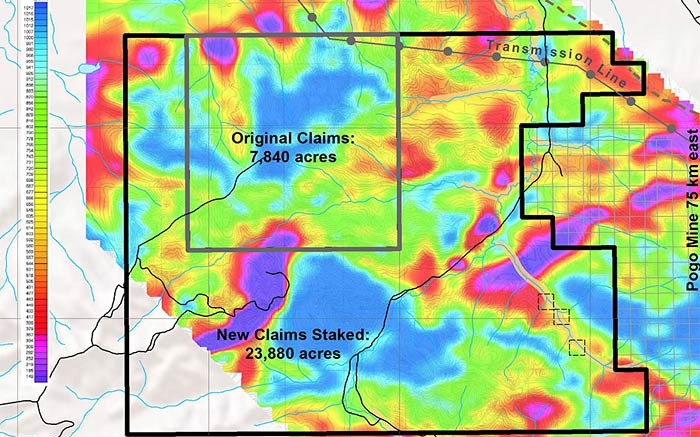VANCOUVER — The management team at Northern Empire Resources (TSXV: NM; US-OTC: PSPGF) believe it’s an opportune time to get back into the project-generation game, and that the early stage Richardson gold project in Alaska’s Tintina gold belt is a great place to start.
The company is a reimagining of a vehicle that is likely familiar to those involved in the diamond business. Northern Empire Minerals made headlines via a merger with Stornoway Diamond (TSX: SWY; US-OTC: SWYDF) in 2003 that effectively consolidated the Aviat project on Nunavut’s Melville Peninsula.
The new version of Northern Empire is another venture for geologist John Robins and his Aurora Resource team, which is advancing Kaminak Gold’s (TSXV: KAM; US-OTC: KMKGF) multi-million ounce Coffee gold deposit towards production.
“The Northern Empire brand came from a previous vehicle that had run a similar project-generation strategy under tough market conditions. We’ve recapitalized and rebranded the company, and we’re totally changing the corporate strategy,” director Jim Paterson said during an interview.
“I think the project-generation model works best when you can make low-cost acquisitions, and under current market conditions you certainly have your pick. I don’t think Richardson would be available in better times. It’s imporant to remember that John started out Kaminak with a similar strategy,” he added.
The flagship project consists of 113 sq. km next to the Richardson Highway, 115 km southeast of Fairbanks, Alaska. Power runs through the property, and an all-weather road leads to the site from the highway. Placer gold was discovered in the area in 1905, with at least two instances of past-producing eluvial operations.
Richardson sits within the Yukon-Tanana Terrane, which is defined as a composite crystalline geological terrane bounded by the right-lateral Denali Fault to the north and the Tintina Fault to the south.
All the lode gold occurrences at the project are consistent with the intrusion-related gold deposit model, while gold mineralization at the Democrat pit along the Richardson lineament is associated with a linear cluster of quartz-feldspar porphyry “fingers.”
“We’ve acquired all the high ground in the area, and there’s been a variety of drilling, bulk sampling and a significant amount of soil and chip samples. There’s still plenty of placer potential up there, but we’re only interested in a vector into that hard-rock source,” explained exploration manager Bill Cronk.
Since 1987, the property has seen: 3,600 rock samples, 3,540 soil samples, 135 sq. km of airborne magnetics and electromagnetics, 52 reverse-circulation holes and 39 core holes.
Historic efforts also include a bulk-sampling program at the Democrat Dyke using a relatively low-tech recovery system that recovered 2,200 oz. gold from 77,000 tonnes of material.
Gold mineralization often holds a volatile elemental component; strong elemental pathfinder associations, including bismuth and antimony; brecciation; and intense sericite and limonitic alteration.
“The geophysics highlight and explain most of the prospects we have on the land package by showing us contrast where we need to see it, because typically along rock boundaries you have structural movement and mineralization,” Cronk continued.
“It also outlines strong lineament features that are important players in terms of the northwest-trending Richardson gneiss. Then the magnetics highlight the intrusives, and the entire model we’re looking at here is intrusive-hosted deposits,” he explained.
Top-of bedrock-soil sampling has highlighted multi-square-kilometre footprints of anomalous gold and intrusion-related pathfinder elements. Priority targets include: Hilltop, Shamrock and the Richardson Lineament.
In early March, Northern Empire optioned the 32 sq. km Hilltop prospect to junior Sonoro Metals (TSXV: SMO; US-OTC: BGMNF), which can earn 60% in the property in exchange for $3 million in exploration and 1 million shares. The companies expanded the land position a week later via staking, and Hilltop now covers 130 sq. km next door to Richardson proper.
“We figured we didn’t have the capital to do justice to the entire property as a junior company, so we opted to focus on Hilltop. That being said, as the project evolved we determined it was important to protect the flank and a couple of promising anomalies,” Sonoro president and CEO Kenneth MacLeod added.
“We were looking at adding to our portfolio in Mexico. There have been some security concerns in that part of the world recently, and we ideally wanted to get involved in a jurisdiction where political risk was low. We looked for projects around B.C., for example, but the Hilltop scenario and Northern Empire really stood out for us,” he continued.
Rock samples taken by previous operators at Hilltop returned grades ranging from 0.1 gram gold per tonne to 55.5 grams gold, as well as values of silver and bismuth typical of nearby intrusive-related deposits like Sumitomo Metal Mining’s Pogo mine and Kinross Gold’s (TSX: K; NYSE: KGC) Fort Knox mine.
The companies are outlining a $250,000 inaugural exploration campaign at Hilltop, which will involve soil sampling and trenching. Cronk adds that the existing access road will be widened and improved to accommodate excavators, while a camp is set up near the site. Sonoro will fund the program and Northern Empire will act as operator.
“Part of the entire intrusive-related concept has as much to do with the pathfinder elements as the geological setting and ages,” Cronk said. “We have a perfect setting for Tintina mineralization, and we have arsenic, stibnite, antimony, bismuth, and that sort of basket. It’s a model we need to further develop.”
Northern Empire was formed in early December out of the old Prosperity Goldfields vehicle after a 1-for-5 share rollback and $1-million financing. The company retains the rights to Prosperity’s 590 sq. km Kiyuk Lake project in southern Nunavut, and recently picked up the 34 sq. km El Reventon silver prospect in Durango, Mexico.
Northern Empire reported cash and equivalents of $887,400 at the end of December, and closed at 10¢ per share at press time. The company has 19.5 million shares outstanding for a $1.95-million market capitalization.


Be the first to comment on "Northern Empire rises again with an eye on Alaskan gold"